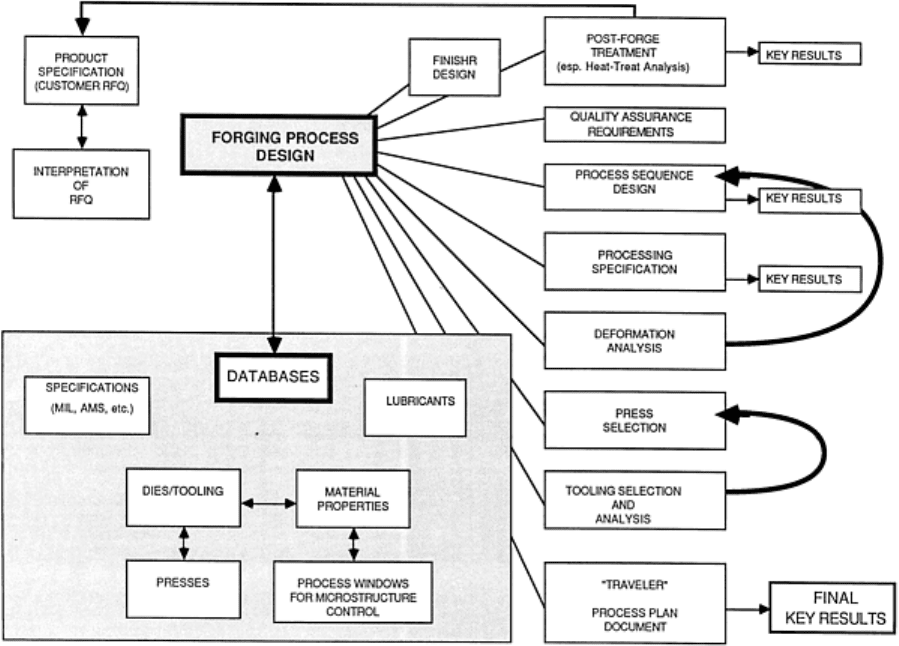ASM Metals HandBook Vol. 14 - Forming and Forging
Подождите немного. Документ загружается.


Alloy composition Primary melter
Alloy cleanliness Primary melter
Mechanical properties Heat treater/forging metallurgist
Final microstructure Heat treater/forging metallurgist
Final finishing (for example, chem-milled)
End-user/forger
Forging identification Forger
Process design related factors
Heat treatment End-user/forging metallurgist
Forging sequence design Forging designer/metallurgist
Preform design Forging designer
Stock allowances Manufacturing/forging designer
Billet size requirements Forging designer
Forging temperature Forging metallurgist
Forging die temperature Forging metallurgist
Lubrication practice Forger
Forging strain rate Forging metallurgist
Load/ram velocity requirements Forging designer/FEM analyst
Press selection Manufacturing engineer
Die design related factors
Forging dimensional accuracy Die designer/FEM analyst
Defect-free forgings (no laps, and so forth)
Die designer/FEM analyst

Die life Die designer
Die strength Die designer
Forging Process Design
H.L. Gegel and J.C. Malas, Air Force Wright Aeronautical Laboratories/Materials Laboratory; S.M. Doraivelu and V.A. Shende,
Universal Energy Systems, Knowledge Integration Center
Tasks Performed in Forging Manufacture
If the overall procedure in the production of forgings in a typical company were examined, the following major tasks
would be found to be necessary components of the manufacturing operation:
• Receive and interpret request for quotation (RFQ)
• Input part geometry into computer-aided design (CAD) system
• Identify constraints imposed by specifications in RFQ
• Identify billet stock sources
• Check incoming billet stock for quality
• Prepare billet for heating/forging
• Determine forging sequence (blocking, preforming, and so forth)
• Design dies
• Select forging temperatures and strain-rates
• Choose forging technique (hot-die, isothermal, and so forth)
• Select forging equipment
• Manufacture dies
• Ascertain furnace cycles and environments (atmosphere control, and so forth)
• Determine lubricants required
• Select intermediate operations such as trimming of preforms
• Inspect finish forging
• Use identification method (serial numbers, and so forth) to track workpieces, drawings, dies, and so on
• Determine heat treating and finishing operations
• Test finish forging to see it meets customer specifications
• Verify packing and shipping requirements
Most forge houses have standard in-house process specification sheets, and "travelers," or specification sheets that
actually go with the individual forging (or batch of forgings) to ensure that proper practice is followed.
Forging Process Design
H.L. Gegel and J.C. Malas, Air Force Wright Aeronautical Laboratories/Materials Laboratory; S.M. Doraivelu and V.A. Shende,
Universal Energy Systems, Knowledge Integration Center
Software Tools Available to Support Task Automation
Five main classes of tools are necessary for the implementation of an integrated system for forging process design:
• Geometry Representation Tools.
A significant portion of the design and analysis task is manipulation
and definition of geometry
• Knowledge-based expert systems (KBES) provide experience-
based initial guesses to design problems.
These initial guesses can then be iterated upon by rough and detailed analysis tools
• Rough analysis tools are fast and cost effective: They prescreen initial guesses provided by the KBES
so
that inappropriate designs are not passed to more expensive detail analysis tools
• High-accuracy detail analysis tools serve mainly to validate selected designs
• An intelligent DBMS stores all data used by the aforementioned tools. Access to this data,
whether it be
by the user or by one of the aforementioned tools, should be guided and controlled; the forging
knowledge-
based DBMS must control the sequence of creation and use of the data by users and tools
according to the dictates of the methodology
These tools are further examined below, with a brief discussion of their functionality, input requirements, and outputs.
The input requirements and outputs do not represent a description of the "file formats," but rather of the conceptual use of
the tools. Further, input data that would be data based is not noted here, but is described later in the section "Required
Data Base to Support Software Tools." (Data base information is data that is insensitive to a specific forging operation;
for example, materials flow stress, thermophysical properties, and so forth.)
Geometry Representation Tools
CAD Systems. It is necessary to provide geometry information to the simulation and expert systems programs in an
appropriate fashion. Much of the U.S. manufacturing industry has already started to use computer-aided drafting systems,
and it would be ideal to use this computerized geometry representation for forging process design.
Computer-aided design commercialization is fairly mature, and options range from low-cost PC-based systems to full-
function mainframe software. The choice is mostly a matter of performance versus cost.
• Input requirement:
Interactive geometry creation, or geometry data files (IGES, that is Initial Graphics
Exchange Specification, or proprietary) (Ref 4)
• Output:
Engineering drawings, cross sections for analysis, section geometric properties, solid model
geometric properties, numerical control (NC) machining "tapes"
Callable Graphics Libraries. The above-mentioned CAD software is generally highly proprietary and, as such, is not
readily useable in applications software. Furthermore, CAD systems offer a capability exceeding the requirements of
graphics application codes. It is therefore necessary to use callable graphics libraries that can be integrated into graphics
application routines. Several such graphics libraries are commercially available.
• Input: These are not used directly by the end-
user, rather, they are programming tools for the software
applications developer
• Output: Graphics output to and input from the user
Knowledge-Based Expert Systems
Automated forging design (AFD) is a knowledge-based system implementing rules for establishing stock
allowances to a finished part for the various manufacturability criteria, such as forgeability, machining, die mismatch, and
so forth. In addition, it establishes a suitable parting line. This software is being developed under a U.S. Air Force
Manufacturing Science program (Ref 5).
The program can currently handle two-dimensional geometries; thus, for general three-dimensional components, the
designer has to determine which set of two-dimensional sections should be provided to the AFD expert system.
• Input requirements: Material specification, two-dimensional geometry of the required part
• Output: Two-
dimensional geometry of the required part with a forging envelope applied as well as a
parting line for final forging operation
Blocker Initial Design (BID). This program (Ref 6) adds allowances to the finish forging according to experience
guidelines that generate a preform geometry for the finish forging. The BID program is also being developed under the
U.S. Air Force Manufacturing Science program.
BID could be used iteratively to work back all the way to a starting billet requirement. The program can currently handle
two-dimensional geometries; thus, for general three-dimensional components, the designer has to determine which set of
two-dimensional sections should be provided to the AFD expert system.
It is worth noting that the use of a two-dimensional section is quite appropriate, because this is in fact the way experts
currently handle design. It would be advantageous to attempt to identify the two-dimensional sections that should be
given to the KBES.
• Input requirements: Geometry at the end of a forging step, and material specification
• Output: Preform geometry for the forging step
Material Modeling Environment (MME). Given the nominal strain to be developed in a deformation step, MME
(Ref 7) provides a material processing map that identifies ranges of the stable temperature and strain rate required to forge
the part. Further, based on microstructural observation data, a desired range for generating the required microstructure can
be superimposed on the stability map. This allows determination of press velocities and forging temperatures.
• Input requirements: Flow stress data a
s a function of strain, strain rate, and temperature; microstructural
observations
• Output:
Multiple graphic views of the data set, stability and structure evolution maps, and constitutive
representation of the material response suitable for ALPID (Analysi
s of Large Plastic Incremental
Deformation) simulations
Rough Analysis Tools
FINISHR. This FORTRAN program (Ref 5) is intended to give approximate load distributions on the forging dies using
the slab method. Again, this program operates on two-dimensional sections; however, this is consistent with the
functionality of the KBES.
• Input requirements: Geometry at the end of forging step, and material specification
• Output: Estimated load distribution on the dies
Detail Analysis Tools
ALPID System. This system of programs includes two-dimensional rigid-visco-plastic FEM analysis programs,
including a coupled heat-transfer capability. The system also includes a remeshing-interpolation program to permit
continued simulation after the initial mesh becomes too distorted. There is a postprocessor included in the system. More
details about ALPID are given in the section "Required Data Base to Support Software Tools" in this article. The ALPID
program has been actively used in various research programs as well as in industry, and is considered reliable and mature.
• Input requirements:
Geometry of dies and workpiece, FEM mesh, boundary conditions, material
constitutive "equation," thermal/physical properties of materials
• Output: Geometric description
, in textual or graphic representation, of the progress of deformation in
terms of mesh distortion, detailed distributions of strain, strain rate, velocity, stress, and temperature

TOPAZ. This is a FEM heat transfer analysis program developed at Lawrence Livermore Laboratories. TOPAZ (Ref 8)
provides complete capabilities, including convection, conduction, and radiation. An associated program, FACET (a
subprogram of TOPAZ), can provide view factor calculation for the radiation.
• Input requirements:
Geometric description of part, FEM mesh, thermophysical properties of forging,
boundary conditions, heat transfer coefficients, and view factors for radiation
• Output: Transient temperature field in the forging, as a stand-
alone result or as input to NIKE for
analyzing the thermally induced stresses
NIKE. This FEM stress analysis program (Ref 9) (also developed at Lawrence Livermore Laboratories) can provide
several material models, that is, elastic, elastic-plastic, and so forth. For one of the intended applications in the integrated
forging methodology, the elastic-plastic capability is of interest, to simulate heat treatment induced stresses in the forged
part. It is also possible to use NIKE for detailed stress analysis of the dies, although other commercial packages are
popularly used.
It is important to note that NIKE and TOPAZ are coupled to provide thermal-stress analysis. At present, remeshing is not
provided; however, if significant deflections do occur, the heat treatment is not viable anyway, so the simulations are
quite appropriately terminated at this point.
• Input requirements:
Geometric description of the part, FEM mesh, boundary conditions, and
thermomechanical properties
• Output: Stress and deflection field in the forging/die
NIKE and TOPAZ are provided with their own mesh generator and postprocessor, and if integration and uniform user
interface are required, some code development will be necessary.
Knowledge-Based Intelligent DBMS
KI SHELL. This is a knowledge-based integration shell (Ref 10) for providing a frame-based methodology. The shell is
built on top of a relational data base. This shell has been under development for 10 years at The Ohio State University,
and is now being used commercially.
Relational Data Base. The KI SHELL is mapped onto a relational data base.
References cited in this section
4. R.J. Mayer, IGES: One Answer to the Problems of CAD Database Exchange, BYTE, 1987, p 209-214
5. J.P. Tang, S.-I. Oh, D.W. Birch, and K. Hoang-
Vu, "Manufacturing Science Program to Develop a
Computer-Aided Engineering (CAE) System for Die (Mold) Design and Manufacturing," AFWAL-TR-86-
405, Air Force Wright Aeronautical Laboratories, 1986
6.
K.R. Venuri, P.S. Ragupathi, and T. Altan, "Automatic Design of Blocker Forging Dies," Paper presented at
the 14th NAMRC Conference, Minneapolis, 1986
7. H.L. Gegel, J.C. Malas, S.M. Doraivelu, J.M. A
lexander, and J.S. Gunasekera, "Materials Modeling and
Intrinsic Workability for Simulation of Bulk Deformation," Advanced Technology of Plasticity,
Vol 1,
Springer-
Verlag, 1987, p 1243; and product publication of Universal Energy Systems Knowledge
Integration Center, 1987
8. A.B. Shapiro, "TOPAZ 2D--A Two-
Dimensional Finite Element Code of Heat Transfer Analysis,
Electrostatic and Magnetostatic Problems," Report UCID 20824, July 1986
9. J.O. Hallquist, "NIKE-2D, a Vectorized Implicit Finite Deformation,
Finite Element Code for Analyzing
the Static and Dynamic Response of 2-D Solids," Lawrence Livermore National Laboratory, 1983

10.
V. Ashok and J. Ramanathan, A Knowledge-Based Software Development Assistant, in
Proceedings of
Spring DECUS, U.S. Symposium, Digital Equipment Computer Users Society, May 1987, p 35
Forging Process Design
H.L. Gegel and J.C. Malas, Air Force Wright Aeronautical Laboratories/Materials Laboratory; S.M. Doraivelu and V.A. Shende,
Universal Energy Systems, Knowledge Integration Center
Required Data Base to Support Software Tools
Workpiece and Die Thermophysical Properties. The data for performing heat treatment simulations on the finish
forging include specific heat, density, thermal conductivity and elastic modulus of the forging material, all as a function
of temperature. The thermal properties of the die material are necessary to conduct the deformation simulation for
nonisothermal forging. The elastic modulus of the die is necessary for the stress analysis of the dies to verify the
capability to withstand the loading.
Workpiece Constitutive Response. The flow stress of the workpiece, or billet material, as a function of strain, strain
rate, and temperature is required for dynamic material modeling (using MME), as well as for deformation simulation
(using FINISHR and ALPID). The constitutive response is also important if plastic deflections are to be predicted in heat
treatment simulations (NIKE and TOPAZ).
Process Window for Microstructure Control in the Forging. The dynamic material modeling approach
implemented by the material modeling environment (MME) package provides direct guidance for selecting stable
processing conditions when taking defects into consideration. It is still necessary to further restrict the viable processing
range in terms of microstructure control. Thus data on processing-microstructure correlations is necessary to ensure that
forging is done at a temperature and strain rate that not only gives stable flow but also develops the desired
microstructure.
Die-Workpiece Interface Data. The thermomechanical deformation simulation (ALPID) requires data on the
effective friction factor and the heat transfer coefficient at the interface. In general, these data vary with the lubricant used
during forging and the force applied on the interface.
Tooling Data Base. A typical tool setup involves back-up die-blocks behind the forging die; further, these back-up dies
are frequently used in conjunction with multiple sets of contour dies. It is useful to data base this inventory, in order to
help determine whether new back-up tools will be necessary. In general, the contour dies are useful for only a specific
part, and the need to data base them is uncertain.
Press/Hammer Data. In order to determine the appropriate forging equipment for a particular forging operation,
information on the press/hammer capacity is needed. Equipment data of relevance for presses is the velocity load
capability and the velocity stroke capability. For hammers, the energy availability and stroke frequency are important.
This data can be compared with the requirements computed by the deformation analysis tools, to support equipment
selection.
Forging Process Design
H.L. Gegel and J.C. Malas, Air Force Wright Aeronautical Laboratories/Materials Laboratory; S.M. Doraivelu and V.A. Shende,
Universal Energy Systems, Knowledge Integration Center
Forging Process Design Method
Having outlined the conceptual method of automating forging design and manufacturing, it is appropriate to examine the
detailed, domain-specific aspects of the methodology. In the previous sections, the tasks that must be performed and the
available tools to support these tasks were examined. The proper sequencing of these tasks, propagation of information

between tasks, and the correct data basing of the results to prevent redundancy while maintaining a uniform user interface
are the objectives of knowledge-based integration. Providing the detailed description of sequence, information
propagation, and so forth, in a specific application (in this case, forging manufacture) is referred to as method design.
Forging Process Design Task Outline. An overview of the tasks that must be performed in developing a forging
manufacturing plan is presented in Fig. 1. This representation shows inputs, redesign when analysis invalidates a design,
and data base information required by a process designer or planner. This section provides a conceptual description of the
tasks presented in the representation in Fig. 1.
Fig. 1 Forging process design task overview.
Task 1: Integration of Geometry Representation. As is the case with most process design, forging design is
conducted backwards, starting with the finished component requirement. The finished part representation is usually in the
form of a computer-aided drafting geometry data base, plus the structure/property specifications, which are typically not
data based at this point. The approach, therefore, will be to leave the integration of structure and property data to future
work.
Computer-aided drafting technology is already in the marketplace as a competitive business, and such tight coupling with
the data base would require access to proprietary data base structures. It has been proposed that integration be
accomplished through standardized geometry files by means of standards such as the IGES.
Task 2: Initial-Guess Finished Forging Geometry. The identification of an initial-guess finished forging must
take into account criteria such as the forging material, recommended process, available equipment, and so forth. In
addition, if the property and structure specifications require the finished forging to be heat treated, the selected design
should be capable of developing the required properties with available heat treatment practices without resulting in either
cracking or distortion.
At present, a KBES prototype is available to provide an initial guess for a finished forging AFD along with the rough
analysis tool (FINISHR) to estimate producibility of the finished forging. (Both the codes were developed under U.S. Air
Force funded programs.) There is, however, no such KBES rough-analysis support to evaluate the heat treatability of the
finish forging, so it will be necessary to go directly to detail analysis. NIKE and TOPAZ can be used for evaluation of
heat treatability. NIKE, a stress analysis code coupled with TOPAZ, a heat transfer code, can be used to provide thermal
transients and associated stresses and deflections, if any, to determine heat treatability.
It is already apparent at this point that a large amount of data is necessary to support each aspect of design and analysis.
This need to access significant amounts of diverse data in a context-sensitive fashion is a circumstance ideally suited to
the capabilities of knowledge-based integration, which makes all data readily accessible to the user.
Task 3: Forging Sequence Design. After the finished forging has been adequately defined, it is necessary to design
a sequence of forging steps, tracing backwards to an acceptable starting billet geometry (usually a cylinder or a cuboid).
In this task, the solution space can again be reduced through another KBES prototype, BID. This expert system starts with
the finish forged geometry (or the intermediate step geometry) and applies criteria sensitive to the material, equipment,
and geometry to provide an input geometry to that forging step.
Task 4: Processing Parameter Selection. The dynamic material modeling approach implemented in the MME
product provides a fundamental methodology for selecting temperature and strain-rate at which stable deformation can be
expected.
In addition to stable flow, data base information on processing-microstructure correlations will be used to identify the
process window within which both stable metal flow and appropriate evolution of microstructure are achieved.
Task 5: Detail Analysis of the Forging Sequence. The initial-guess design and rough analysis constitute the
automatic die and process design. In order to avoid costly die tryouts, the proposed sequence for manufacturing the
forging can be verified using the ALPID system for FEM analysis. This system of programs, developed under U.S. Air
Force sponsorship, is capable of analyzing any two-dimensional metal forming operation, including temperature-transient
effects.
The ALPID system is integrated into the knowledge-based system by means of an intelligent preprocessor, to which
relevant design information can be propagated. The preprocessor then generates the necessary inputs, including an
appropriate constitutive "equation" representation, to the ALPID program.
It should be noted that unlike the design tasks, which work backwards from the final requirement, the analysis task
progresses in the forward direction. This reversal of methodology is done primarily because, in general, initial conditions
are not known for intermediate steps in a nonisothermal forging sequence without reheats.
Task 6: Die Design and Stress Analysis. The detail analysis of the deformation sequence, using ALPID, also
provides the detailed loading distribution on the die surface. At present, there is no KBES for recommending an
appropriate die block size, and designer judgment must be relied on. However, the KI SHELL can provide support in
terms of propagating the forging design geometry to any appropriate stress analysis program.
Task 7: Generate Key Results. The culmination of process design and analysis is the generation of an appropriate
manufacturing plan. In the forging industry, especially for critical applications, the manufacturing specification (plan)
actually accompanies the forging. These "travelers" should be generated by an integrated system. In addition, because the
design and analysis tasks may extend over several terminal sessions, intermediate status should be made available as "key
results" (see Fig. 2 and 3). An actual traveler is an extended and complex document, but a schematic representation is
provided in Fig. 4.

Fig. 2 Example of key results; results of forging sequence design.

Fig. 3 Example of key results; results of forging parameter selection.
